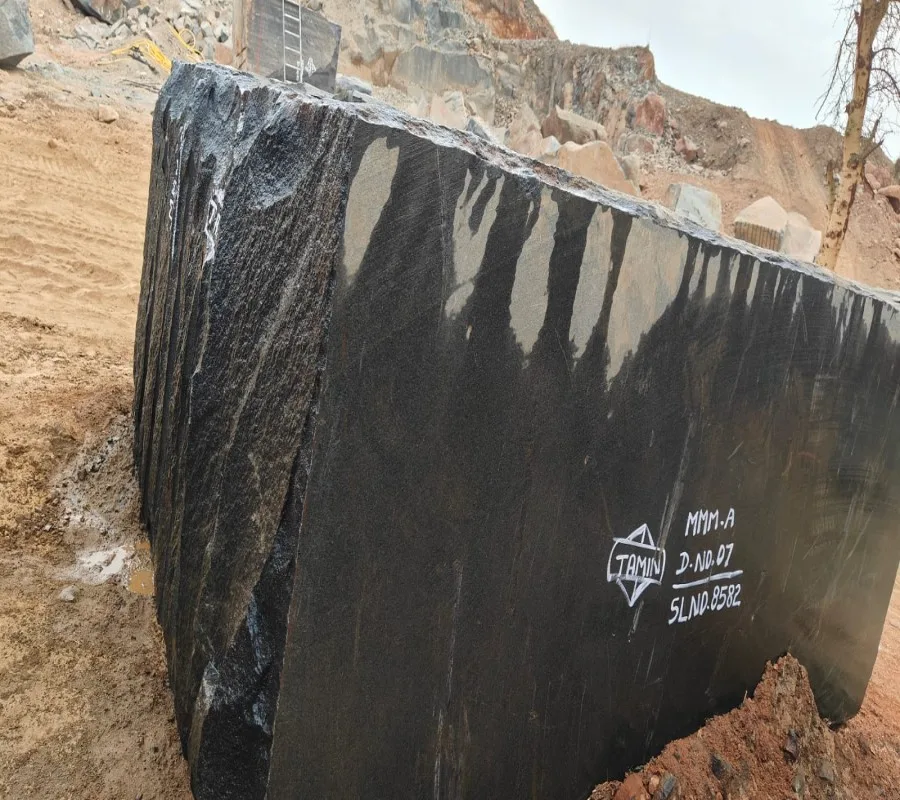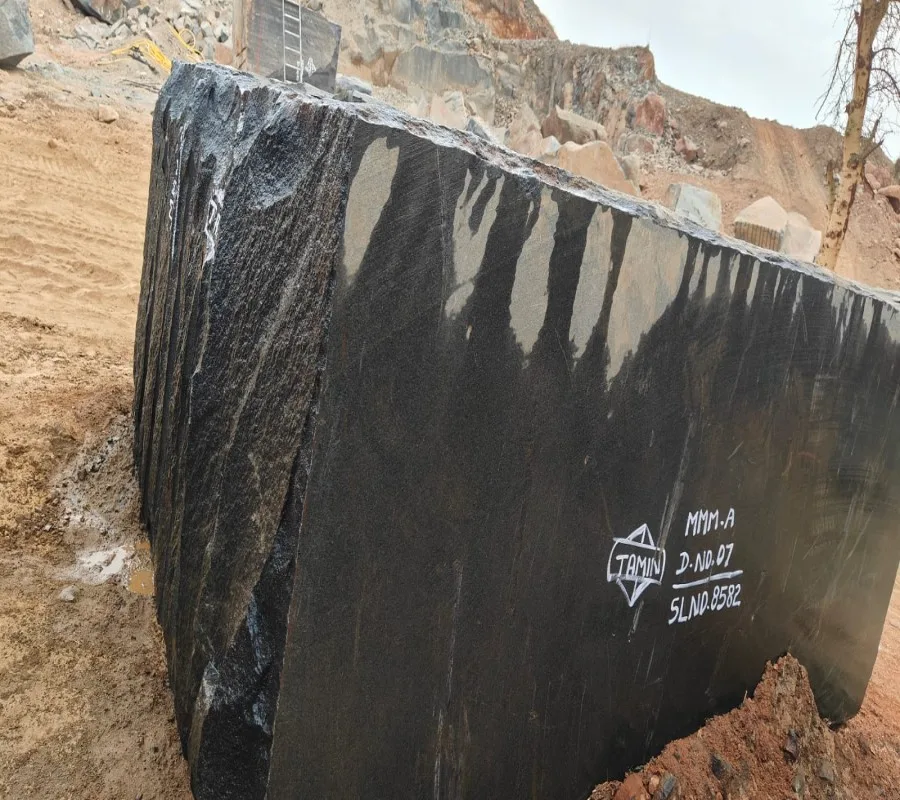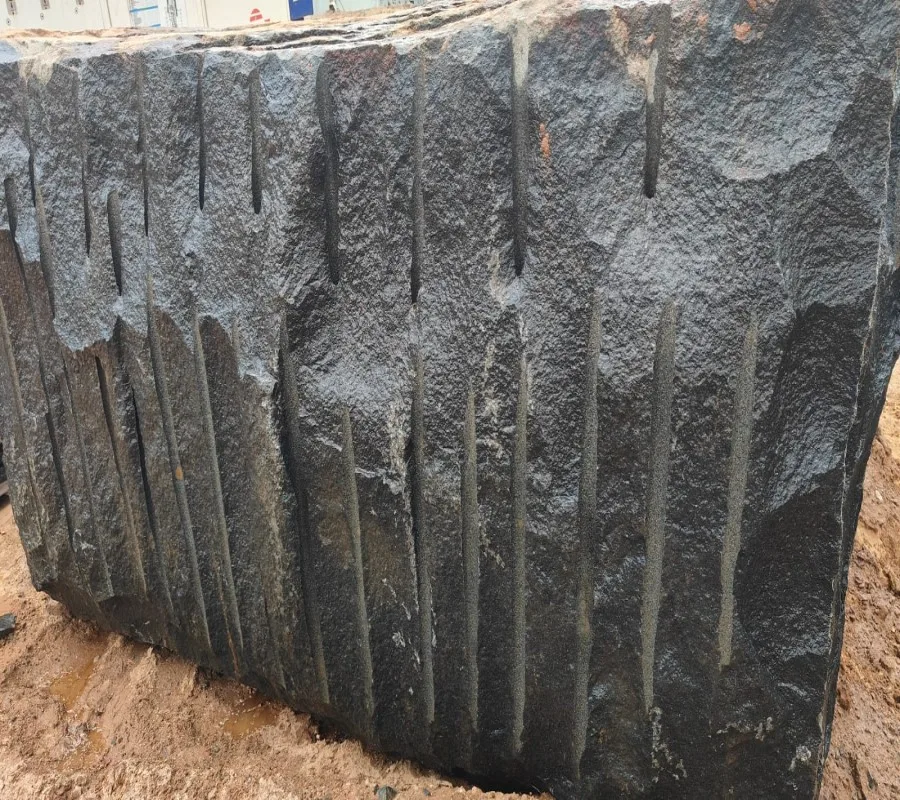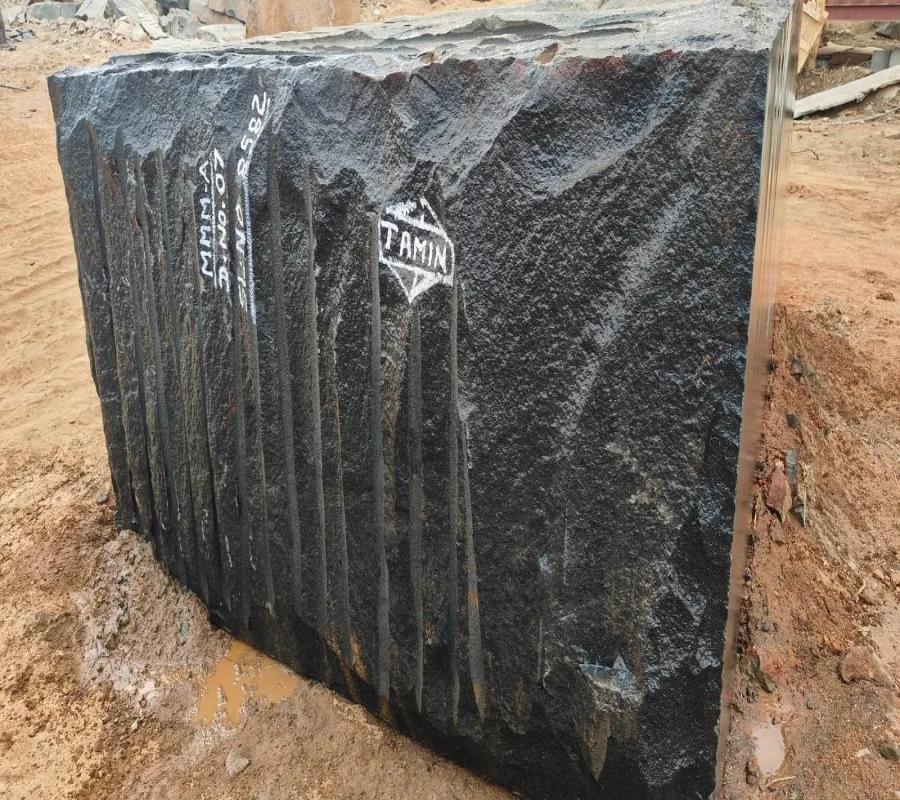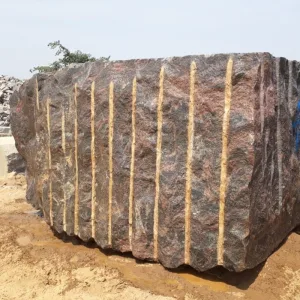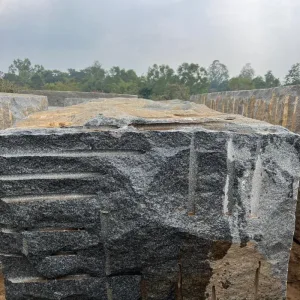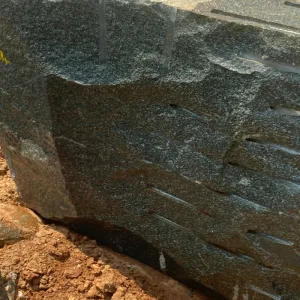G20 Bengal Black Rough Granite Blocks represent unprocessed raw material extracted directly from quarries in South India, specifically from the Gudipala Mandal region of Chittoor district in Andhra Pradesh and Puttur Village near the famous Tirupati temple in Karnataka. These locations benefit from proximity to Chennai Harbor—India’s second-largest seaport—enabling efficient container export logistics for international buyers.
The material is geologically classified as gabbro—a coarse-grained intrusive igneous rock formed from magma cooling slowly beneath Earth’s surface during the Precambrian period over 2.5 billion years ago. While commercially marketed as “granite” internationally, European Standard applications require proper designation as gabbro in technical documentation for regulatory compliance. This classification difference reflects geological accuracy rather than quality or performance variation.
Rough blocks serve as fundamental raw material for fabricators and processors who transform them into finished products including slabs, tiles, cut-to-size pieces, and specialized applications. The uniform grey-black coloration with fine light white grains or silvery minerals evenly distributed throughout creates an attractive background ideal for projects requiring consistent black tones without dramatic veining or color variation. The green dots visible on the black base create distinctive texture while contributing to exceptional durability.
G20 Bengal Black has earned particular recognition in international monument and tombstone markets, especially throughout Europe where consistent black granite remains highly sought for memorial applications requiring dignity, permanence, and weather resistance. Processing facilities regularly export container loads specifically for this application, with established supply chains serving fabricators in Poland, Bulgaria, Romania, Greece, Russia, Ukraine, and Sweden.
Beyond monuments, the material processes into commercial flooring tiles for shopping malls and hospitals—particularly popular in flame-finished surface providing slip resistance for high-traffic areas. The very hard, close-grain structure ensures long-term durability under heavy pedestrian loads. Additional applications include residential and commercial countertops, building cladding systems, staircases, fireplaces, tub surrounds, shower vanities, and backsplashes where the uniform black base provides versatile design compatibility.
Performance and Quality
G20 Bengal Black demonstrates performance characteristics typical of high-quality igneous rocks with notably consistent properties across blocks from established quarries. The fine-to-medium grain structure creates tight interlocking crystals providing exceptional compressive strength suitable for load-bearing structural applications and high-traffic commercial flooring. The very hard, close-grain material resists scratching, chipping, and wear better than many softer stones.
The uniform color represents significant quality advantage for projects requiring visual consistency across large installations. Unlike granites with dramatic veining or color variation, G20 maintains consistent grey-black tones minimizing pattern-matching challenges when fabricating multiple slabs or tiles from different blocks. This consistency makes it particularly valued for monument applications where somber, dignified appearance requires uniformity without distracting variations.
The material demonstrates excellent weather resistance suitable for both interior and exterior applications, including climates with freezing temperatures. The dense, low-porosity structure resists moisture penetration that could cause freeze-thaw damage in cold climates—critical for outdoor monuments, exterior cladding, and landscape features exposed to seasonal temperature cycling. The stone’s documented durability in European markets with harsh winters confirms suitability for demanding outdoor conditions.
Quality grading within G20 Bengal Black includes Standard, Premium, and Commercial tiers reflecting block characteristics including color consistency (darker blocks command premium), grain uniformity, natural fissure frequency, and block size. Premium-grade blocks with minimal natural imperfections and larger dimensions yield more usable material per block, reducing processing waste and justifying higher cubic meter pricing. Commercial-grade blocks may contain more natural fissures or color variation but remain suitable for applications where absolute uniformity matters less.
Materials and Construction
Rough blocks arrive directly from quarries in unprocessed condition, displaying natural rough-hewn surfaces from extraction procedures. Modern quarrying employs controlled drilling, wire sawing, and wedge-splitting techniques that extract large intact blocks while minimizing unnecessary fracturing. The blocks’ “rough” designation indicates they have not yet undergone gang-saw cutting, polishing, or finishing processes—fabricators receive raw material for subsequent processing according to project requirements.
Block dimensions vary based on quarry geology and extraction methods, with typical sizes ranging from 220-280cm length, 90-105cm width, and 70cm+ height. Buyers specify minimum dimensional requirements based on intended applications—larger blocks suit gang-saw slab production, while smaller blocks may serve tile or cut-to-size fabrication. The cubic meter pricing reflects that larger blocks generally command premiums due to reduced handling costs per unit volume and higher yield of large-format pieces.
The green dots visible throughout G20’s black base result from specific mineral compositions formed during the gabbro’s original cooling and crystallization. These light-colored inclusions—likely plagioclase feldspar or minor mineral phases—create subtle texture without compromising structural integrity. Far from being imperfections, these features contribute to the stone’s characteristic appearance and durability, with the interlocking crystalline structure providing exceptional strength.
Quality control at source quarries includes visual inspection for natural fissures, color consistency evaluation, and dimensional verification before blocks leave quarry sites. Reputable exporters maintain direct quarry relationships ensuring consistent supply of quality-graded material matching buyer specifications. Buyers should request photographs of actual available blocks before finalizing purchases, as natural stone characteristics vary even within single quarry faces.
| Color | Deep Black with fine consistent grey blue flower grain |
| Origin | South India |
| Texture | Compact, high-density, uniform grain |
| Size | 180up*60up, 200up*100up, 200up*120up, 260up*160up |
| Density | Approximately 2,600 – 2,800 kg/m³ |
Processing and Downstream Applications
Fabricators receiving rough blocks process them through several stages creating finished products. Gang-saw cutting transforms blocks into slabs of specified thickness (typically 20mm, 30mm, or custom thicknesses). The resulting slabs then undergo surface finishing including polishing for reflective surfaces, honing for matte finishes, or flaming for textured slip-resistant surfaces ideal for commercial flooring and outdoor applications.
Tile production utilizes smaller blocks or slab off-cuts, cutting calibrated pieces in standard sizes (30cm×30cm, 40cm×40cm, 60cm×60cm) with thickness typically 10-20mm depending on application. Cut-to-size production fabricates custom dimensions for specific architectural applications including countertops, vanities, stairs, cladding panels, and monument components.
The uniform color and minimal veining simplify processing compared to heavily figured granites—fabricators achieve consistent results without extensive pattern-matching requirements or concerns about color breaks disrupting visual flow across installations. This processing efficiency contributes to G20’s commercial competitiveness, as reduced waste and simplified fabrication translate to favorable pricing for end-users despite premium quality.
Maintenance and Standards
Rough blocks require no maintenance during storage beyond protection from contamination. Fabricators should store blocks on level ground with adequate drainage preventing water accumulation, covered with tarps or housed under shelter protecting from excessive weather exposure that might cause surface staining before processing.
Finished products processed from G20 blocks conform to ASTM C615 specification covering material characteristics, physical requirements, and sampling methods for granite dimension stone used in building and structural purposes. While technically gabbro, the material’s performance characteristics meet or exceed granite standards for absorption, density, compressive strength, modulus of rupture, and flexural strength.
Buyers should verify quarry source and request quality-grade confirmation before purchase. Reputable exporters provide detailed specifications including block dimensions, cubic meter calculations, quality grade designation, and quarry location. For container-load orders, buyers typically specify minimum block sizes, acceptable quality grade, and total cubic meter requirements—suppliers then select appropriate blocks meeting specifications.
Warranty terms for rough blocks vary by supplier. Typical coverage addresses significant natural defects rendering blocks unusable for intended purposes but excludes minor natural variations inherent to natural stone. Specific warranty duration and terms: Not publicly disclosed; confirm exact coverage with your supplier before purchase, particularly for large orders where material consistency matters critically.
Pros & Cons
Advantages
- Uniform color consistency: Grey-black base with minimal variation enables large installations without pattern-matching challenges; ideal for monuments requiring somber uniformity
- Exceptional durability: Very hard, close-grain structure resists scratching, wear, and weather; suitable for high-traffic commercial flooring and exterior applications
- Freeze-thaw resistant: Dense, low-porosity composition withstands cold-climate conditions; proven performance in European markets with harsh winters
- Monument market premium: Established demand in Europe for tombstone/memorial applications commands consistent pricing and reliable export markets
Considerations
- Quality grade variability: Premium vs. Commercial grade blocks show 40-60% price differences and 20-25% yield variations; specification precision essential
- Processing infrastructure required: Rough blocks need gang-saw facilities, polishing equipment, and skilled labor; not suitable for retail end-users
- Gabbro vs. granite classification: Must be designated as gabbro (not granite) in European Standard applications for regulatory compliance
Who Should Buy
Ideal Buyers
- Monument/memorial fabricators requiring consistent black granite for headstones, tombstones, and cemetery installations, especially those serving European markets
- Commercial flooring contractors specifying durable flame-finished granite for shopping malls, hospitals, airports, and high-traffic public facilities
- Stone importers/distributors with gang-saw processing facilities and established markets for black granite slabs and tiles
- Large-scale developers seeking cost-effective, uniform black stone for commercial projects where consistent appearance matters more than exotic patterns
- Export-focused processors in countries near India with competitive labor costs enabling value-added processing before re-export
Not Recommended For
- Retail consumers or small projects requiring finished slabs/tiles (purchase processed materials from distributors instead)
- Buyers without gang-saw processing capabilities or established fabricator relationships for block conversion
- Projects requiring exotic veining, color variation, or decorative patterns (consider other granite varieties with figuring)
- Small-volume buyers unable to purchase minimum container loads (typically 20-25 tons rough blocks)
- Buyers in European markets unable to accommodate gabbro classification in technical specifications and permit documents
FAQs
Q1: What is the difference between G20, G30, and G40 Bengal Black granite grades?
The G-number designations represent color intensity grades: G20 is grey-black with fine white grains (standard), G30 is darker with less white grain visibility, and G40 is the darkest- almost pure black with minimal light-colored inclusions. G40 commands highest prices due to rarity and monument market preference for deepest black. Buyers should specify desired G-number when requesting quotes as pricing varies significantly.
Q2: Why must Bengal Black be classified as gabbro in Europe if it’s sold as granite globally?
Geologically, Bengal Black is gabbro- a coarse-grained intrusive igneous rock similar to granite but with different mineral composition. European Standard EN 12440 requires accurate petrographic classification in technical documents for regulatory compliance. This doesn’t indicate inferior performance; gabbros often equal or exceed granite durability. The classification matters for building permits and specifications in EU markets but not elsewhere.
Q3: How many cubic meters of G20 blocks fit in a standard shipping container?
A 20-foot container typically holds 10-12 cubic meters (25-28 tons), while a 40-foot container accommodates 20-25 cubic meters (52-58 tons) of rough blocks. Actual capacity depends on individual block dimensions and how efficiently they pack—larger uniform blocks pack more efficiently than mixed sizes. Suppliers provide exact loading plans before shipment showing specific blocks assigned to your container. [Container loading industry standards]
Q4: Can I purchase a few cubic meters of G20 blocks for a small project, or must I buy full containers?
Most exporters require full 20-foot container minimum (10-12 m³) for direct export. Some consolidators offer LCL (Less than Container Load) service starting at 2-3 m³ minimum but charge 30-50% premiums per cubic meter plus additional handling fees. Small fabricators often partner for consolidated shipments or purchase from domestic importers who already containerized material and can sell smaller quantities.
Q5: What is the practical yield difference between Premium and Commercial grade G20 blocks?
Premium-grade blocks yield 85-92% usable slabs after gang-sawing, while Commercial-grade yields 65-75% usable material. For a 3.5 m³ Premium block at $375/m³ ($1,312 total) yielding 90% (3.15 m³ usable), cost per usable m³ is $416. A Commercial block at $240/m³ ($840 total) yielding 70% (2.45 m³ usable) costs $343 per usable m³—narrower difference than raw pricing suggests, especially for monument applications where downgraded pieces have limited value.
Q6: Why is G20 Bengal Black so popular specifically for European monument applications?
European cultural preferences for cemetery memorials emphasize somber, dignified uniformity requiring consistent black coloration without distracting variations. G20’s grey-black base with fine white grains provides appropriately solemn appearance while the uniform color ensures headstones from different blocks match visually. The material’s proven freeze-thaw resistance in European climates and competitive pricing compared to domestic European granites have established strong supply chains. India processes and exports many containers specifically for this market.

